Since 24 June 2019, the only legal tender in Zimbabwe has been the new “Zimbabwe dollar” (Z$, ISO code ZWL), also known as the “RTGS dollar” or the “zollar”. It includes Zimbabwean bond notes, bond coins and mobile money such as Ecocash. New Zimbabwe dollar banknotes were issued in November 2019. The value of the currency is volatile. The exchange rate published on xe.com refers to old Zimbabwean dollars so is completely wrong.
However, as of 23 December 2019, there is a shortage of Zimbabwe dollar notes, and it’s not possible to make cash withdrawals using an international bank card. It is impossible for foreigners to obtain cash in the country; you must bring foreign currency cash with you.
As of January 2020, most retailers and service providers are trading their products in U.S. dollars or pegging their prices in Zimbabwe dollars using U.S. dollar black market rates. Some retailers and public transport operators are no longer accepting denominations lower than the Zimbabwe dollar coin. Wikivoyage articles generally quote prices in U.S. dollars.
There are many ATMs which take Visa and MasterCard. However, you will not be able to withdraw money from any ATMs, so bring plenty of cash. Try to obtain Zimbabwean dollars before you arrive, otherwise you will have to change your U.S. dollars after you arrive. If bringing U.S. dollars, bring smaller denomination notes, e.g. US$20 and below. Anything larger is unlikely to be accepted. Change will be given in Zimbabwean dollars.
Many banks do not have enough bank notes due to a shortage of paper, so will only change U.S. dollars for Ecocash. Registering for Ecocash is recommended. You will need your ID to buy an EcoNet SIM card at EcoNet shops or other small phone shops. You can then register for EcoCash, but you will need to produce your ID again to activate your account. You can then load your account at a bank, and spend money in most shops using your PIN.
A growing number of businesses accept Visa and MasterCard in Zimbabwe, however shop workers are often resistant to use them. Be careful what currency your card is charged in, otherwise you may get charged US$10 instead of Z$10!









